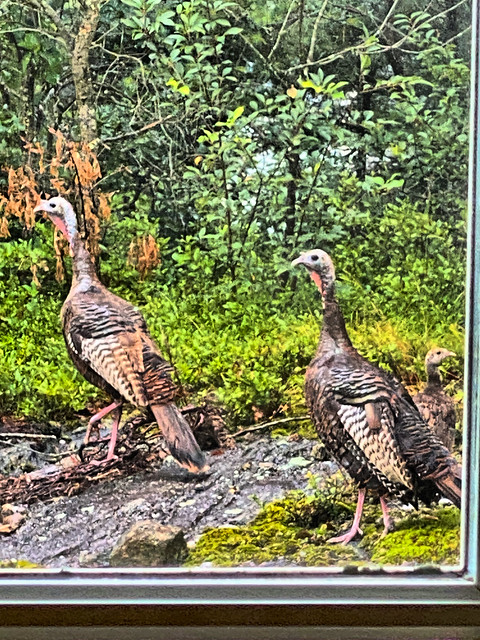Although Wild Turkeys are fairly common in our neighborhood, we have only seen them a couple of times in the yard since we joined the household of our daughter's family in early 2022. We could have missed some of their visits, as they can be very furtive, especially when accompanied by their young.
On July 17th, MaryLou happened to look out the window and was surprised to see two hens with three poults (two are visible in these poor iPhone photos):
They were too close by to fit in the viewfinder of my digital camera:
We hoped that the turkeys would find some of the seed under the feeders and maybe return, but they retreated quietly.
In contrast, probably the most common bird species in our neighborhood posed on the back fence near me as I was watching the deer out in the clear-cut. This perky little Tufted Titmouse seemed to be begging to be seen and photographed:
She turned to provide a better view of her "notched" left ear:
On July 20 three adult does along with a six-week old fawn appeared on the small side lawn. The daylilies were in full bloom and I had to shoot between the blossoms and feeders from the windows in our front door. What my pictures lacked in quality may have been countered by the sentiments they provoked. The fawn briefly nuzzled up to its mother:
When MaryLou spotted a Red-shouldered Hawk resting on the back fence, about 30 Meters (96 feet) away, I had to shoot through a stained porthole window:
I was surprised at how much detail I was able to capture, as evidenced in these cropped portraits:
In an attempt to obtain a better view, I carefully moved out the door, but the hawk saw me and took flight. Note the distinctive light "crescents" which contrast with the black tips of its primary flight feathers:
A baby Eastern Milk Snake sunbathed on a garden step:
On our morning walk we admired a nice variety of daylilies in bloom:
Breezes broke up the reflections on the lake:
On July 22, the crescent Moon peered through the clouds over a colorful sunset:
As the sky darkened, I enjoyed a pleasant view from the covered patio:
This week's header: Sunset and crescent Moon
= = = = = = = = = = = = = = = =
My Corner of the World
________________________________________________
Please visit the links to all these posts to see some excellent photos on display
________________________________________________


































































